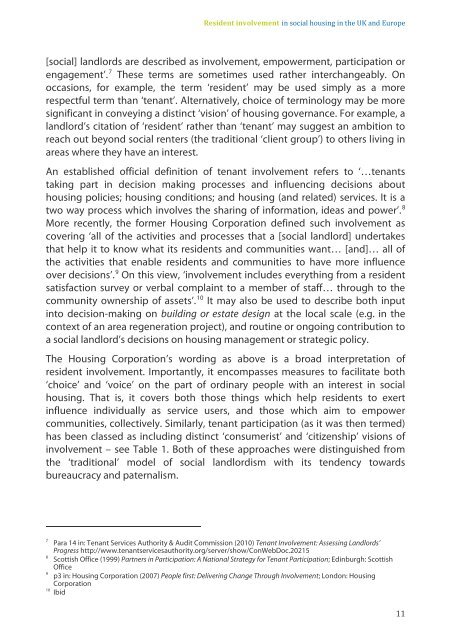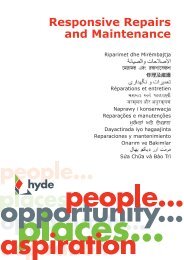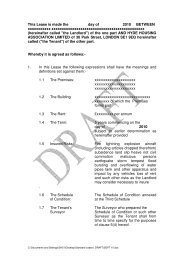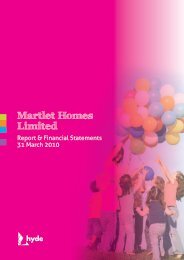Resident involvement - Hyde Housing Association
Resident involvement - Hyde Housing Association
Resident involvement - Hyde Housing Association
You also want an ePaper? Increase the reach of your titles
YUMPU automatically turns print PDFs into web optimized ePapers that Google loves.
<strong>Resident</strong> <strong>involvement</strong> in social housing in the UK and Europe<br />
[social] landlords are described as <strong>involvement</strong>, empowerment, participation or<br />
engagement’. 7 These terms are sometimes used rather interchangeably. On<br />
occasions, for example, the term ‘resident’ may be used simply as a more<br />
respectful term than ‘tenant’. Alternatively, choice of terminology may be more<br />
significant in conveying a distinct ‘vision’ of housing governance. For example, a<br />
landlord’s citation of ‘resident’ rather than ‘tenant’ may suggest an ambition to<br />
reach out beyond social renters (the traditional ‘client group’) to others living in<br />
areas where they have an interest.<br />
An established official definition of tenant <strong>involvement</strong> refers to ‘…tenants<br />
taking part in decision making processes and influencing decisions about<br />
housing policies; housing conditions; and housing (and related) services. It is a<br />
8<br />
two way process which involves the sharing of information, ideas and power’.<br />
More recently, the former <strong>Housing</strong> Corporation defined such <strong>involvement</strong> as<br />
covering ‘all of the activities and processes that a [social landlord] undertakes<br />
that help it to know what its residents and communities want… [and]… all of<br />
the activities that enable residents and communities to have more influence<br />
over decisions’. 9 On this view, ‘<strong>involvement</strong> includes everything from a resident<br />
satisfaction survey or verbal complaint to a member of staff… through to the<br />
community ownership of assets’. 10 It may also be used to describe both input<br />
into decision-making on building or estate design at the local scale (e.g. in the<br />
context of an area regeneration project), and routine or ongoing contribution to<br />
a social landlord’s decisions on housing management or strategic policy.<br />
The <strong>Housing</strong> Corporation’s wording as above is a broad interpretation of<br />
resident <strong>involvement</strong>. Importantly, it encompasses measures to facilitate both<br />
‘choice’ and ‘voice’ on the part of ordinary people with an interest in social<br />
housing. That is, it covers both those things which help residents to exert<br />
influence individually as service users, and those which aim to empower<br />
communities, collectively. Similarly, tenant participation (as it was then termed)<br />
has been classed as including distinct ‘consumerist’ and ‘citizenship’ visions of<br />
<strong>involvement</strong> – see Table 1. Both of these approaches were distinguished from<br />
the ‘traditional’ model of social landlordism with its tendency towards<br />
bureaucracy and paternalism.<br />
7<br />
Para 14 in: Tenant Services Authority & Audit Commission (2010) Tenant Involvement: Assessing Landlords’<br />
Progress http://www.tenantservicesauthority.org/server/show/ConWebDoc.20215<br />
8<br />
Scottish Office (1999) Partners in Participation: A National Strategy for Tenant Participation; Edinburgh: Scottish<br />
Office<br />
9<br />
p3 in: <strong>Housing</strong> Corporation (2007) People first: Delivering Change Through Involvement; London: <strong>Housing</strong><br />
Corporation<br />
10 Ibid<br />
11
















